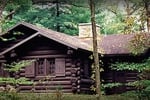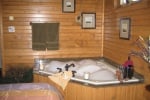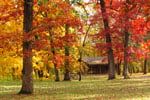CASTLE ROCK STATE PARK
Castle Rock State Park is located three miles south of Oregon, Illinois on Highway 2. The park is centrally located in the Rock River Hills region of Illinois, and its rolling topography is drained by the Rock River. The park is located along the west bank of the Rock River in Ogle County. The park is very representative of the Rock River Hills area with rock formations, ravines, and unique northern plant associations. A sandstone bluff, adjacent to the river, has given the park its name.
The basis for the acquisition of Castle Rock State Park is the protection of natural resouces that are unique to Illinois. A thin layer of glacial till covers this region and several distinctive plant species, remnants of the native forest and prairie, still exist. In one valley, 27 different types of ferns have been identified. The park is one of the largest significant natural areas in the northern part of Illinois.
Most of the outstanding natural features are located in the dedicated Nature Preserve which is protected by state law. Use of the 710-acre preserve will be restricted to scientific study and limited interpretation activities.
Illinois tribes of native Americans inhabited the region until 1730 when the Sauk and the Fox tribes, who were being forced westward by the colonists, invaded and inhabited the region. The native Americans called the river in the new territory "Sinnissippi," meaning "Rocky waters."
In the early 1800s the native Americans were again forced westward into Iowa. In 1831, Blackhawk, the Sauk chief, led his people in a series of raids back into Illinois to reclaim their ancestral lands. The battles that followed were known as the Blackhawk Indian wars. Chief Blackhawk was captured in 1832 and ordered to a reservation.
The Castle Rock area was settled by New Englanders early in the 19th century. This area was proposed as a state park in 1921 by the "Friends of Our Native Landscape," and they were able to acquire some of the land they described as "a unique wilderness remnant of great natural beauty and scientific interest." In 1964, the Natural Lands Institute, a non-profit natural lands preservation group, conducted a public fundraising campaign to preserve part of the Castle Rock area.
Castle Rock was recognized in the state of Illinois as an outstanding area of major scientific importance in 1965. It was established as a project area, and land acquisition by the State was started in 1970.
At the present time, Castle Rock consists of approximately 2,000 acres, 710 of which are designated as an Illinois Nature Preserve. The site was dedicated as a state park in 1978.
Day-UseFishingyes
Huntingyes
Hiking Trailyes
Swimming Beachyes
Bike Trailsyes
BoatingLaunch Rampsyes
CampingElectric Sitesyes
WinterActivitiesyes
Castle Rock does not have a campground except for a primitive canoe camping area. Access to the area is by canoe or boat only.

Cottages and Cabins
We would like to welcome you to the lodge and cabins at White Pines Inn. Located in Illinois White Pines State Park, there are 385 acres of peace and tranquility waiting for you here, with miles of hiking trails to explore the wonders of nature.
6.2 miles from park*

Cottages and Cabins
Located within White Pines Forest State Park in Northwestern Illinois, hidden away in a place that seems like time forgot, discover the historic lodge restaurant, pioneer guest cabins, delightful country gift shop, and entertaining dinner theatre.
6.9 miles from park*
Castle Rock State Park is located near Dixon, Rockford
There are three picnic areas available for use with shelters, picnic tables, playground equipment, grills, toilets, and drinking water. There are also scattered tables for use along the river. One of the picnic areas offers a beautiful view over the Rock River Valley. Two of the park's shelters may be reserved with a fee.
There are six miles of marked hiking trails developed at this time. These trails offer the opportunity to view woodland animals and birds that inhabit the park. The trails' scenic views also offer many chances for the photographers to sharpen their skills. More trails are planned with the park's development. Cross-country skiing and tobogganing are also available when weather permits.
Birdwatchers can enjoy spotting a variety of species, including warblers and woodpeckers. The park's diverse habitats attract many birds throughout the year. Raptors such as hawks are common sights in winter months while spring brings migratory songbirds like orioles and thrushes. Fall migration also offers excellent birding opportunities with large numbers of waterfowl passing through.

Cottages and Cabins
More than just lodging, it's home to 12 cabins located on 10 wooded acres just minutes from Lake Carroll approximately 30 minutes from beautiful state parks such as Mississippi Palisades, Lake Le-Aqua- Na, White Pines Forest, Rock Cut, Morrison-Rockwood. A romantic whirlpool cabin with fireplace or country kitchenette can accommodate everything from intimate parties to family reunions. Enjoy our friendly atmosphere beside the bonfire or in our 8-person hot tub.
25.7 miles from park*

Hotels/Motels
Relax in the rustic beauty and comfort of Starved Rock Lodge, Cabins and Starved Rock Inn. The historic Lodge has 69 guest rooms, which include three bay-window rooms, plus cabins nestled in the woods. Fireplaces can be found in four of the eight sunset cabins near the pool area...
49.6 miles from park*

Hotels/Motels
You will feel right at home when you reach Carroll County, our corner of beautiful Northwest Illinois. The magnificent Mississippi River and outdoor spaces will refresh your spirit and touch our soul.
41.4 miles from park*

Cottages and Cabins
Within a 10 minute drive from Starved Rock and even closer to Matthiessen State Parks you will find a gorgeous, tranquil property with spacious cabins on 50 wooded acres. All with full kitchens and outdoor fire pits. 3 dog friendly.
55.5 miles from park*
Castle Rock State Park is located on IL Hwy 2, 4 miles south of Oregon, IL., 12 miles north of Dixon, IL.
traveling west from the Chicago area on I-90 to Rockford. At Rockford take I-39 south 20 miles to IL Hwy 64. At Exit 104, turn right at Oregon exit, take Hwy 64 west to Oregon. Turn south on IL Hwy 2 for 4 miles to park.
If traveling west on I-88, take Exit 97 at I-39 at Rochelle. Take I-39 north 7 miles to Hwy 64. Go west on Hwy 64 for 15 miles to Oregon. Take IL Hwy 2 south to the park.
If traveling north on IL Hwy 26 south of Dixon, take Hwy 26 to Dixon. In Dixon, take IL Hwy 2 north 12 miles to the park.
If traveling east on I-88 west of Dixon, take the Dixon exit for IL Hwy 26 north. In Dixon, take IL Hwy 2 north 12 miles to the park.







